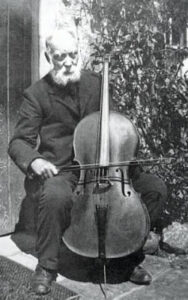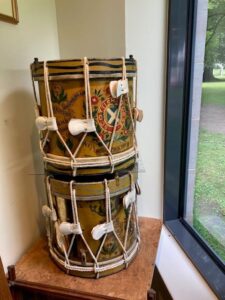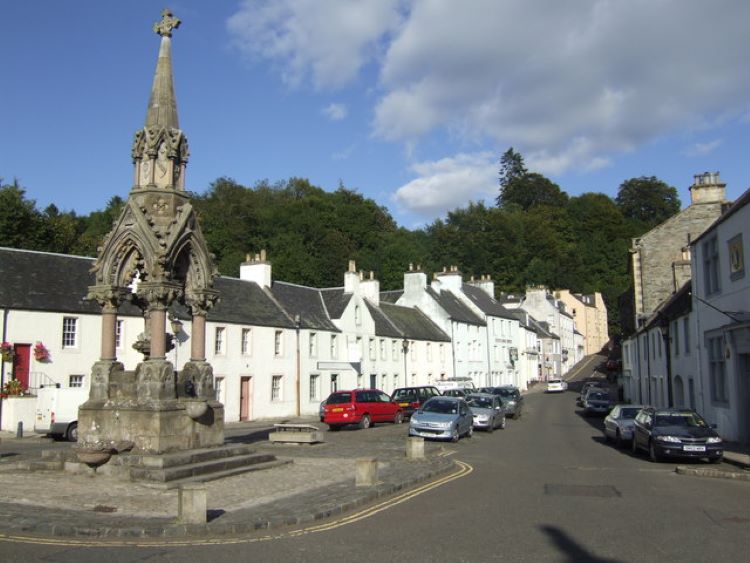With thanks to Pete Clark and Munro Gauld for filling in some of the gaps.
Dunkeld is widely known as the home-town of Niel Gow, whose statue from 2020 has greeted travellers arriving in the town. Thanks to the advocacy of contemporary master-fiddle player Pete Clark, the town has also enjoyed a Niel Gow festival for several years now, and a blue plaque in the town reminds us that Robert Burns stopped and meet with Gow on his famous 1787 song-collecting voyage around Scotland.
Dunkeld has a strong musical culture, with other notable string players and composers in addition to Gow. Gow’s immediate musical legacy included his pupils Red Rob MacIntosh (1745-1807) and John Crerar (c1750-1840), and Duncan McKercher (1796-1833) ‘the Atholl Paganinni’, who often said he was taught by Gow and even if he wasn’t, was influenced by Gow’s style of playing (Jackson, p.61). A player like Gow leaves a musical imprint on any area even if he didn’t teach you directly; players inspired by his teaching and playing include e.g. Malcolm Macdonald, an 18th century cellist born possibly in Breadalbane but who may have played with Niel Gow and whose published books of fiddle tunes placed him ‘in Dunkeld’. Other names and biographies can be found in Helen Jackson’s book Neil Gow’s Inver.
In the case of one family, the Macintoshes, Gow’s teaching left an imprint that lasted over three generations of musicians and composers.
- James MacIntosh (1791-1879) – who learnt fiddle from Gow (possibly Gow’s last pupil), and enjoyed a career playing in the Edinburgh-based ‘Julian Band’ (Jackson, p.47);
- Charles MacIntosh (1797-1867) – younger brother of James, a fiddler in Inver, composer, Free Church precentor and collector of tunes (Jackson, p.49-50); some of his music found its way into the Atholl Collection e.g. the William Dixon manuscript of 18th century Northumbrian small pipe tunes;
- James’s nephews, Charles’ sons, Charlie and James.
- Charlie Macintosh (1839-1922 is known for his interest in botany as well as music, and for his friendship of Beatrix Potter, who holidayed in Dunkeld. A postman all his life, he had lost fingers as a youth in a sawmill accident, but nevertheless managed to play the cello by using the edge of his left hand to stop the strings. Charles had a particular interest in bothy ballads (Jackson, p.55) – manuscripts now in the A K Bell library in Perth, and in the library at Blair Castle.
- His brother James Macintosh (1846-1937), also a postman, played the fiddle, composed music, led a dance band, and established the Dunkeld and District Strathspey and Reel Society along with his friend, Davina Begg, in 1932, when he was the sprightly age of 86. His Reels, Strathspeys, Marches etc (Perth: Patersons, 1932) appeared in print the same year. He also was a keen amateur photographer – and even made his own camera!
 Image: Charles Macintosh of Inver (1839-1922), playing the cello without the fingers of his left hand
Image: Charles Macintosh of Inver (1839-1922), playing the cello without the fingers of his left hand
The Dunkeld Community Archive has recently uncovered handwritten manuscripts by James Macintosh (1846-1937). This fiddle music, hitherto unknown, unplayed and never published, was written throughout James’ life to commemorate local people, places and events. The Dunkeld Community Archive is looking to publish this ‘lost’ music along with the collected fiddle and song compositions of the rest of the Macintosh family. If you are interested in supporting this project, please do contact them!
As well as the music manuscripts, Dunkeld Community Archive also looks after several Macintosh family artifacts, including a length of tartan ribbon given to James Macintosh in 1854 by Count Roehenstart, the grandson and last surviving descendant of Bonnie Prince Charlie. James, whilst herding cattle in a nearby field, witnessed the Inverness mail coach overturning as it came into Inver. The Count was one of the injured passengers and, despite assistance given to him, was to die several days later. He is buried in Dunkeld Cathedral.
The Dunkeld archive also contains records of the Scottish Horse regiment. The splendid drums (photo insert for this post) are going to join the National Museum of Scotland’s collections but other material and photographs associated with the regiment will remain in Dunkeld. The archive welcomes research enquiries and offers of support, and has just launched an ambitious funding drive to improve its facilities for visitors, including researchers – see their GoFundMe for Dunkeld Archive and Museum Extension.
Beating the drum for Dunkeld – Author’s own photograph.
the drum for Dunkeld – Author’s own photograph.
Further information and reading
- Dunkeld Community Archive and Chapter House Museum
- Henry Coates, Charlie Macintosh: Post-runner, naturalist and musician (London: T Fisher Unwin, 1924)
- Charlie Gore, ‘Malcolm MacDonald (1752-1790s), Musician and Composer at Dunkeld’ for Box and Fiddle archive
- Helen Jackson, Neil Gow’s Inver, (Perth & Kinross Libraries, 2000)
And listening –

